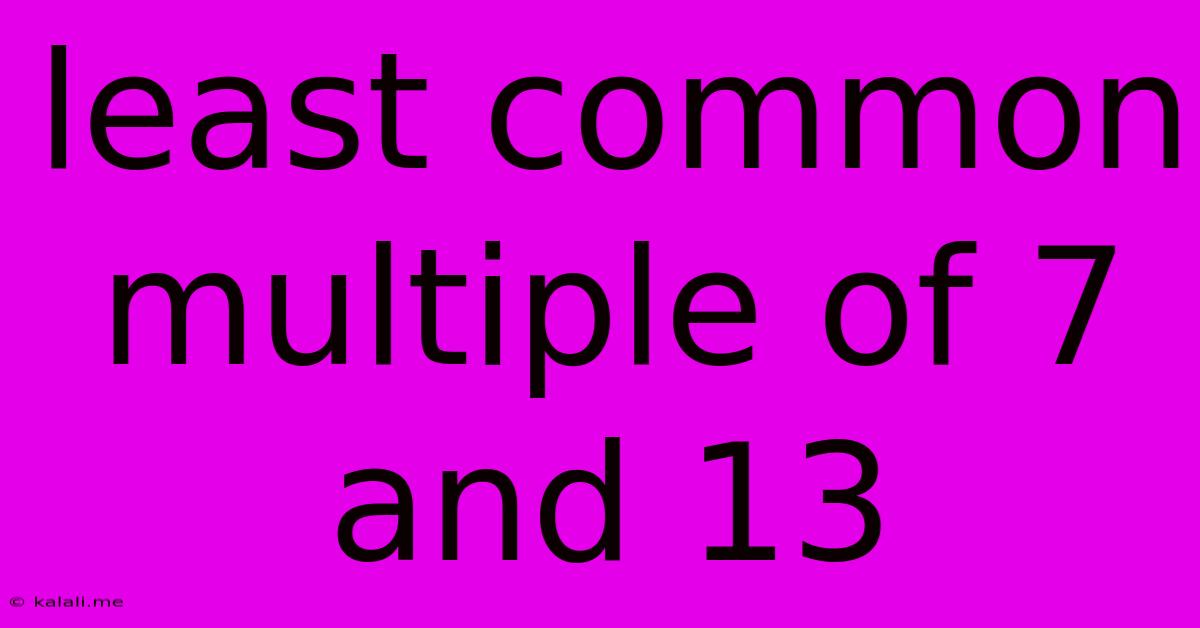Least Common Multiple Of 7 And 13
Kalali
Jun 13, 2025 · 2 min read

Table of Contents
Finding the Least Common Multiple (LCM) of 7 and 13
This article will guide you through calculating the least common multiple (LCM) of 7 and 13, explaining the concepts involved and showcasing different methods for finding the solution. Understanding LCM is crucial in various mathematical applications, from simplifying fractions to solving problems related to cycles and patterns.
What is the Least Common Multiple (LCM)?
The least common multiple (LCM) of two or more integers is the smallest positive integer that is divisible by all the integers. In simpler terms, it's the smallest number that contains all the numbers as factors. This concept is fundamental in arithmetic and algebra, particularly when working with fractions and simplifying expressions.
Method 1: Listing Multiples
The most straightforward approach to finding the LCM of 7 and 13 is by listing their multiples until we find the smallest common multiple.
- Multiples of 7: 7, 14, 21, 28, 35, 42, 49, 56, 63, 70, 77, 84, 91, 98, 105, 112, 119, 126, 133, 140, ...
- Multiples of 13: 13, 26, 39, 52, 65, 78, 91, 104, 117, 130, 143, ...
By comparing the lists, we observe that the smallest number appearing in both lists is 91. Therefore, the LCM of 7 and 13 is 91.
Method 2: Prime Factorization
This method is particularly efficient when dealing with larger numbers. It involves finding the prime factorization of each number and then constructing the LCM using the highest powers of each prime factor present.
- Prime factorization of 7: 7 (7 is a prime number)
- Prime factorization of 13: 13 (13 is a prime number)
Since 7 and 13 are both prime numbers and have no common factors other than 1, their LCM is simply their product:
7 * 13 = 91
Therefore, the LCM of 7 and 13 is 91 using the prime factorization method.
Method 3: Formula using Greatest Common Divisor (GCD)
Another approach utilizes the relationship between the LCM and the greatest common divisor (GCD) of two numbers. The formula is:
LCM(a, b) = (|a * b|) / GCD(a, b)
Where:
- a and b are the two integers.
- GCD(a, b) is the greatest common divisor of a and b.
Since 7 and 13 are coprime (their GCD is 1), the formula simplifies to:
LCM(7, 13) = (7 * 13) / 1 = 91
This confirms our previous findings.
Conclusion:
The least common multiple of 7 and 13 is 91. We've explored three different methods – listing multiples, prime factorization, and using the GCD – to demonstrate the versatility of approaches to solving LCM problems. Understanding these methods equips you with the skills to tackle more complex LCM calculations efficiently. Remember to choose the method that best suits the numbers you're working with. For smaller numbers, listing multiples is often sufficient. For larger numbers, prime factorization or the GCD formula becomes more efficient.
Latest Posts
Latest Posts
-
A Quadrilateral Pqrs Is Inscribed In A Circle
Jun 14, 2025
-
The Key Distinction Between Positive And Negative Reinforcement Is
Jun 14, 2025
-
Which Is Not A Part Of Respiratory System
Jun 14, 2025
-
Which Of The Following Is A Percussion Instrument
Jun 14, 2025
-
The First 15 Elements Of Periodic Table
Jun 14, 2025
Related Post
Thank you for visiting our website which covers about Least Common Multiple Of 7 And 13 . We hope the information provided has been useful to you. Feel free to contact us if you have any questions or need further assistance. See you next time and don't miss to bookmark.